The Interiors and Accommodation of RMS Titanic
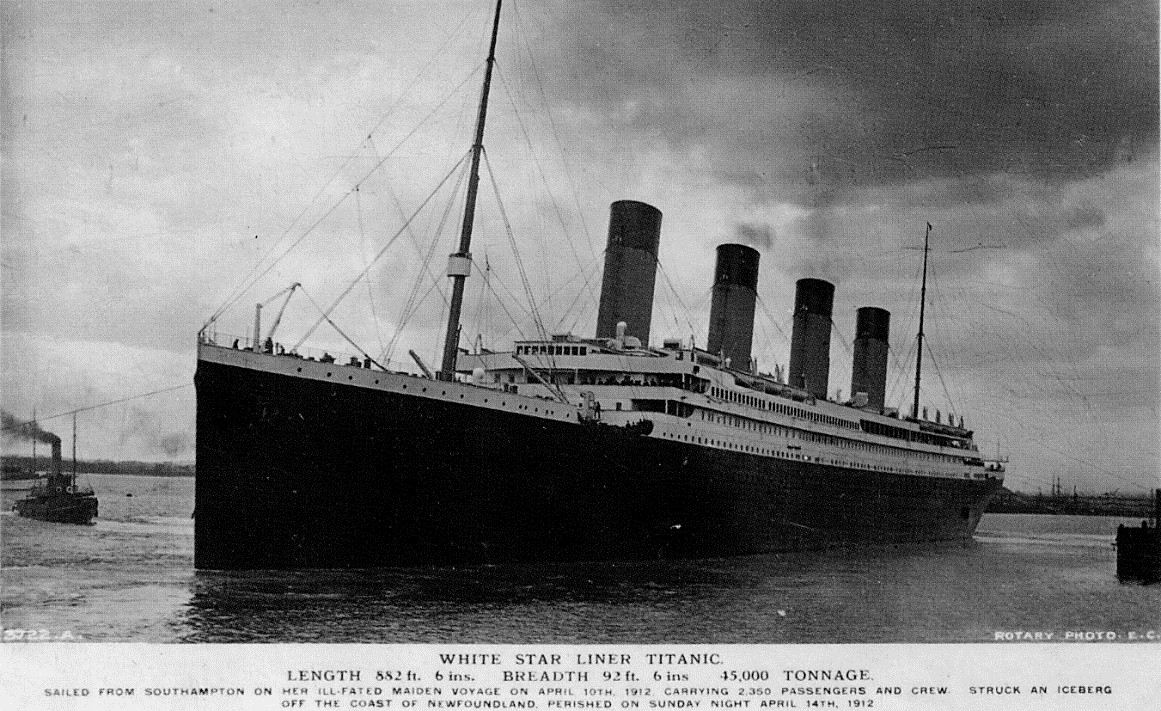
The Shipbuilder, in their winter 1911 edition, wrote on completion of the Olympic that the passenger accommodation was of “unrivalled extent and magnificence ... and the excellent result defies improvement.”
The Olympic and the Titanic could each carry 3,295 people: 2,435 passengers, and crew of 860. Passengers were divided by Class. There were 689 First Class, 674 Second Class and 1,026 Third Class passengers. The Titanic consisted of ten decks shown in cross section and listed below:
Boat Deck [A]
Promenade Deck [B]
Bridge Deck [C]
Shelter Deck [D]
Saloon Deck [E]
Upper Deck [F]
Middle Deck [G]
Orlop Deck
Lower Orlop Deck
Tank Top.
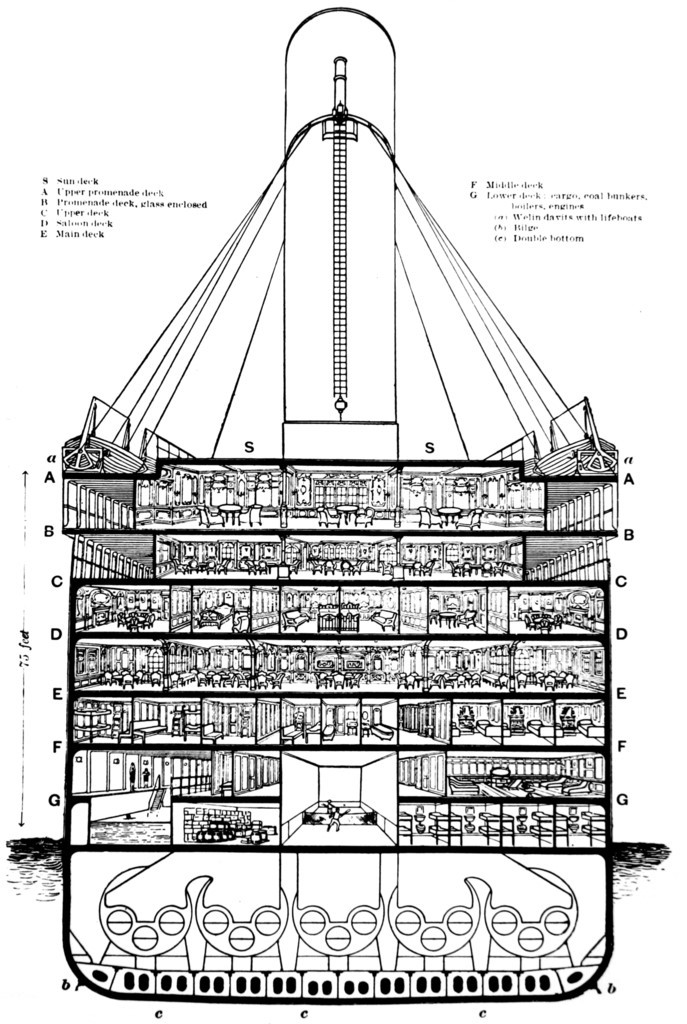
The Promenade Deck, above the Bridge Deck, was largely a wide open promenade area that ran the whole length of the ship giving access to a lounge, smoking room, palm court, writing room and a few cabins. The entire area was reserved for the First Class.
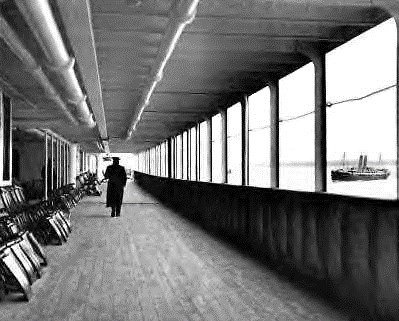
The Boat Deck was mostly reserved for crew members except for a short section was open to First Class promenaders. The officer’s quarters were here, along with the Bridge, wheelhouse and promenade area for use of the crew only.
Passenger accommodation and public areas were located on the Promenade, Bridge, Shelter, Saloon, Upper, Middle and Lower Decks. The other three were reserved for the crew, cargo and machinery.
The Boat and Promenade Decks were above the superstructure of the ship and so did not run the entire length of the ship. The Bridge Deck extended 550 feet, the complete length of the superstructure. The Forecastle (106 feet long) and the Poop Decks (128 feet long) interrupted the length.
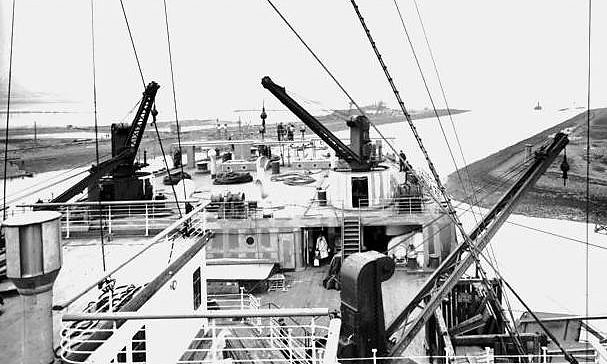
During the Titanic's design, entirely new recreational facilities including a swimming pool, Turkish baths, squash courts and a gym.

First Class Travel
First Class passengers were accommodated on the five levels from the Upper to Promenade decks. In order to easily move from deck to deck there were four elevators installed made by The Otis Elevator Company. The Main Entrance had an imposing Grand Staircase, topped by a transparent dome of iron with a stained glass skylight which allowed natural daylight through. The Grand Staircase as one of the features of the ship was greatly admired. Passengers admired its elegance.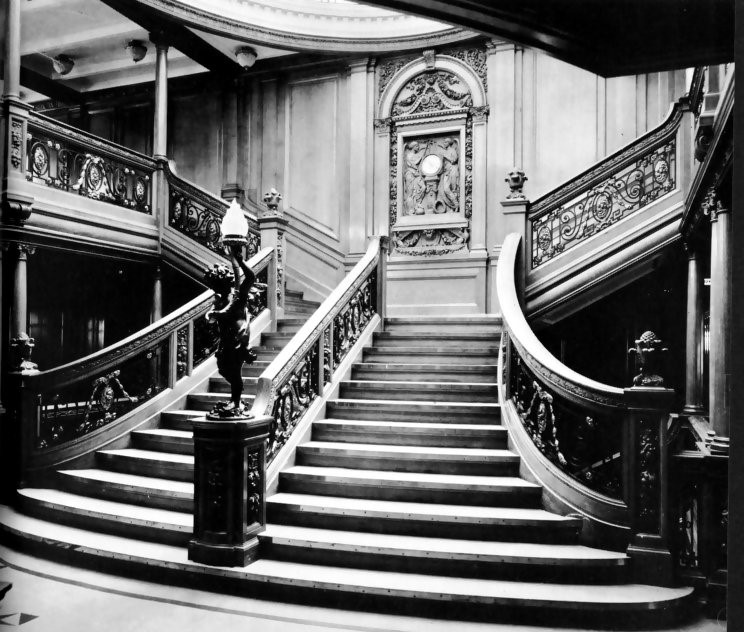
The First Class passengers entered into the large Entrance Hall on B-Deck to be met by stewards, who escorted them to their rooms. The First Class were staying in a “floating hotel.”
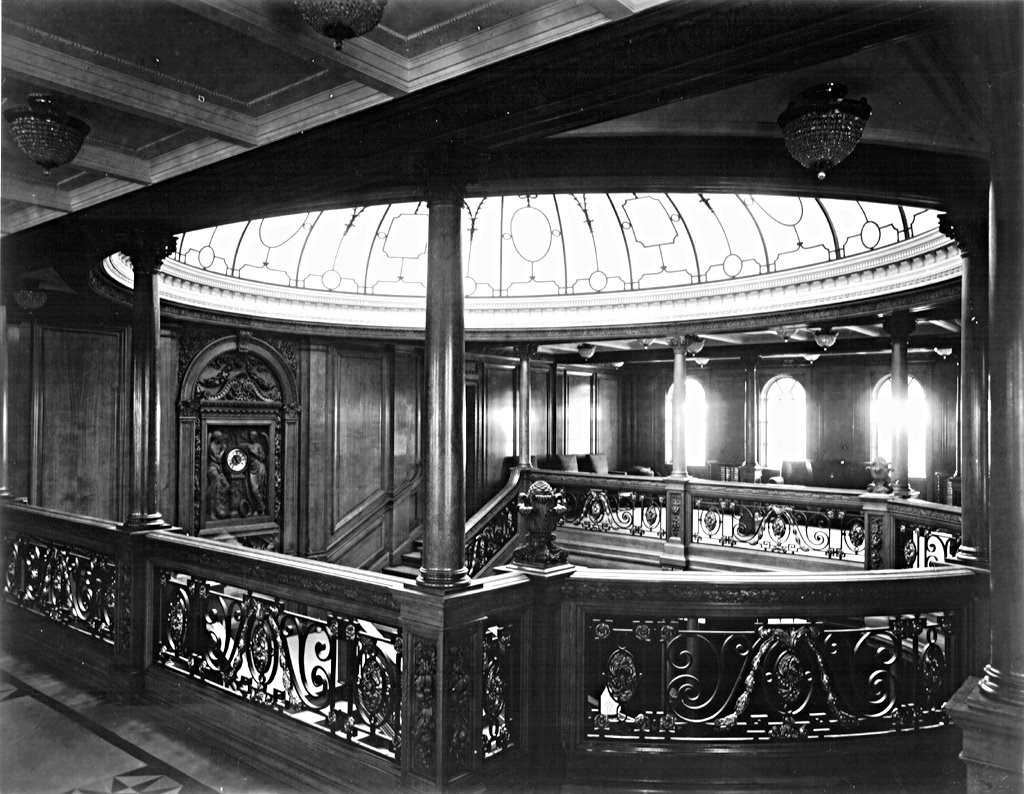
The Second and Third Class passengers were met by stewards to instruct them on how to find their rooms. The First Class Grand Staircase was exactly that. It was over 60 feet from the lower landing to the glass skyline above. It had a seventeenth century William and Mary style with solid oak carved panelling running all the way around. At the foot of the stairs was a Cherub light with a very distinctive wood carving clock behind.
The First Class public rooms included a dining saloon, reception room, and restaurant, lounge, reading and writing room, smoking room and the veranda cafes and palm courts. One of these was the Cafe Parisien.
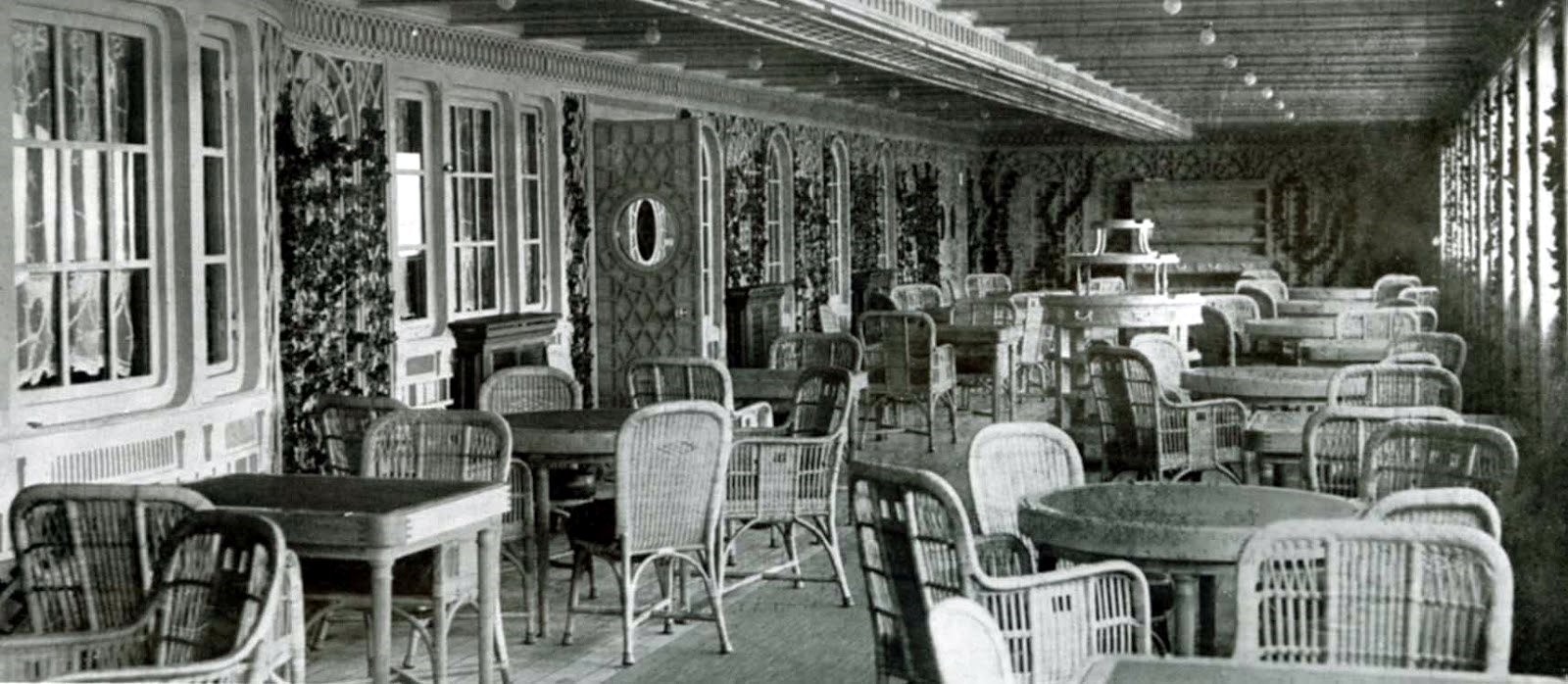
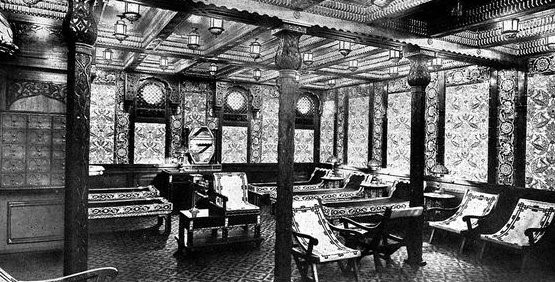
Recreational facilities included a gym and squash court; the sisters were the first liners in the world to have them installed.
The First Class also enjoyed several Turkish and electric baths (as pictured), which although technically saunas, were decorated in an Arabian style. The portholes were covered with a carved Cairo curtain so that when light shone through, an Orient look was given to the room.
First Class Reading and Writing Room
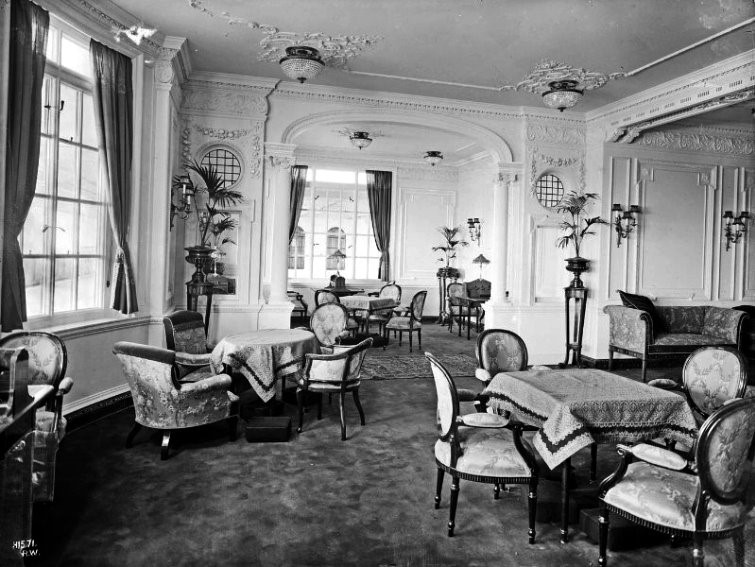
This room was predominantly designed for use by the First Class lady passengers. It was painted in white and furnished elegantly. There was a huge bow window that enabled the occupiers to lookout on to the Promenade Deck. There was a large fire that burned intensely adding warmth to the room.
First Class Lounge
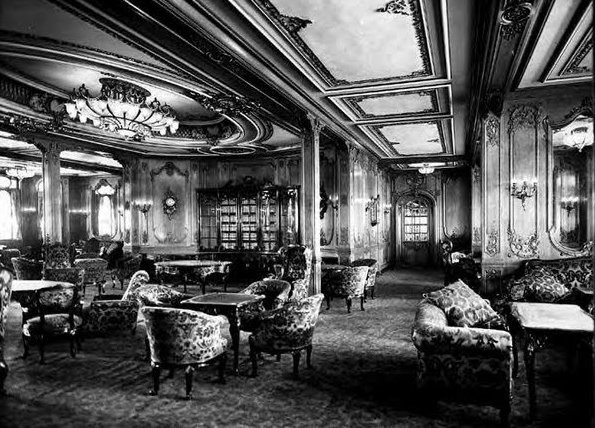
The Lounge was situated on the Promenade Deck and elaborately fitted out. This room was dedicated to reading, conversation, playing cards and other social interactions of the day. It was decorated in the French Louis XV style. The craftsmanship was exquisite. The walls were covered with “boiseries” (elaborate wooden carvings), which gave the room a distinct symmetrical appearance. The room provided a quiet haven enabling passengers to meet, converse or play card games, like bridge. Others just enjoyed afternoon tea.
First Class Smoking Room
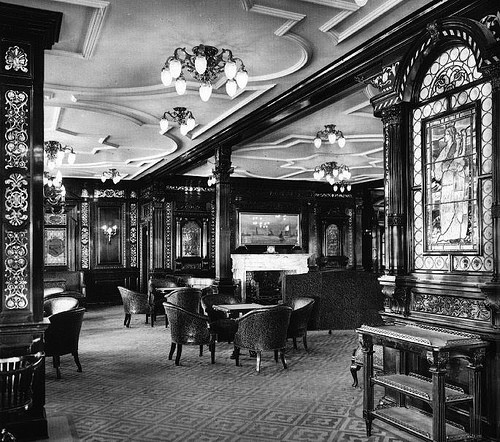
The opulent First Class Smoking Room was situated towards the back of the Promenade Deck. Its walls were panelled in mahogany carved in the Georgian style, and inlaid with mother of pearl.
Above the centrepiece fireplace was a painting by Norman Wilkinson called the “Plymouth Harbour.” The Olympic had a painting by the same artist called “The Approach to the New World.”
Those who required an after dinner drink repaired to the well-stocked bar. Others enjoyed looking at the painted glass windows depicting many different ports from around the world, and other WSL ships.
On the portside of the room was a small Veranda area, which led to the Palm Court areas (30 feet by 25 feet) overlooking the aft Promenade Deck. Walled trellises with climbing plants gave the impression that the room was part of a conservatory. Passengers could sit on wicker chairs to finish their drinks.
First Class Reception Area
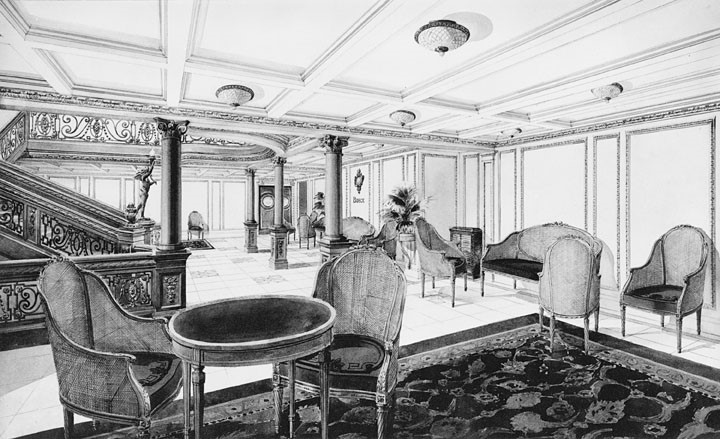
Behind the Grand Staircase was a spacious 54 feet long reception room. It was decorated in the Jacobean style and had a white ceiling and a dark rusty colour carpet. Before dinner, saloon passengers could gather to discuss the day's activities. Some would sit relaxing in its floral patterned grandfather chairs. The Reception Room led directly to the Dining Room.
First Class Dining Room
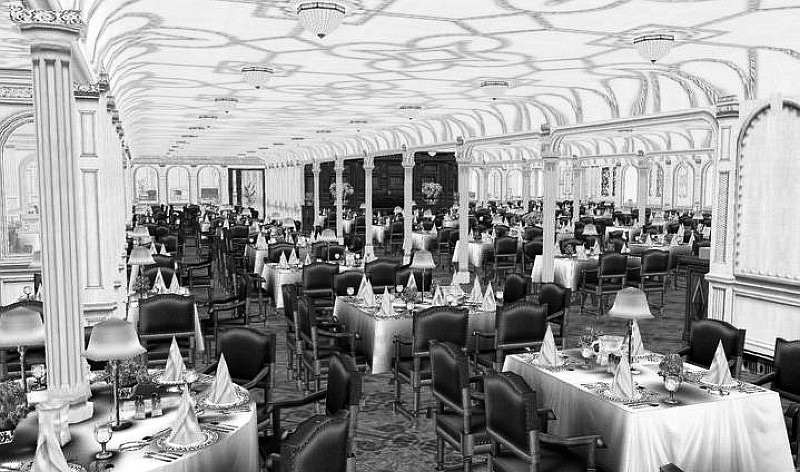
The First Class passengers would certainly dine in style. Their dining room was 114 feet long and spanned the full width of the ship. Seating 532 passengers at once, it was the largest dining room ever seen on a ship. The room was decorated in attractive Jacobean style, and painted in peanut white.
This decoration had been the result of painstaking research. The designs were based on Hatton Hall and some very fine houses in Hatfield, England. The chairs and tables were oak and designed to add luxury and comfort at all times. In those days dinner was considered a very important part of a voyage.
For a sample menu please download our PDF version
First Class À La Carte Restaurant
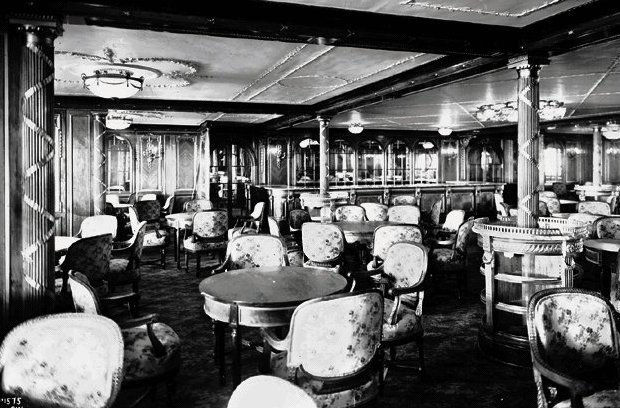
This restaurant served some of the finest of meals but they were not included in the fares of its guests. It added an extra touch of class. The room was decorated in Louis XIV style with floor to ceiling panelling in French light brown walnut. Specially mounted ornaments and mouldings gave a regal effect. Candle-style lamps hung in the centre of the panels.
Plain silk curtains covered the large bay windows that gave a great feeling of spaciousness. Passengers could sit around the tables in groups of two to eight people. An orchestra played to them from a raised platform. Dining would have been a memorable experience.
First Class Accommodation
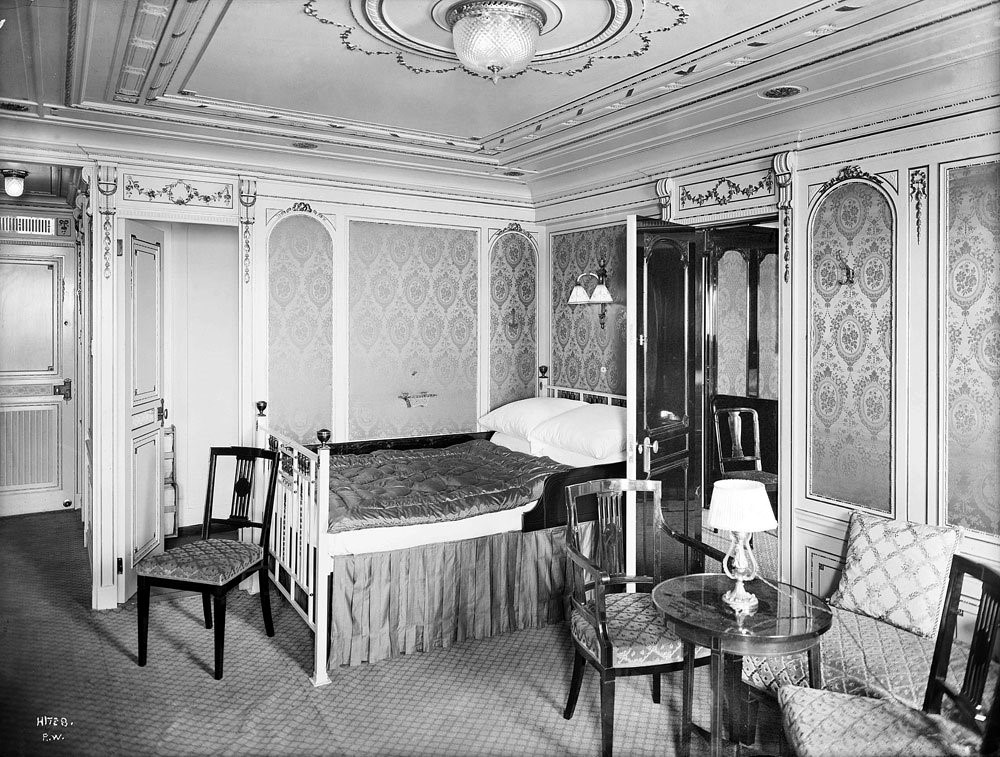
The Titanic provided 39 private suites: 30 on the Bridge Deck and 9 on the Shelter Deck. The suites included bedrooms with private toilet facilities. Each suite had several different rooms: 2 bedrooms, 2 wardrobe rooms and a bathroom.
First Class accommodation also held 350 cheaper standard cabins with single beds. The expensive and exclusive staterooms boasted excellent fittings. Each were decorated in different periodic styles including Louis XVI, Louis XV, Georgian and Queen Anne.
First Class cabins were provided with Vinolia Otto Toilet Soap because (according to the advertisement shown below) it was “the highest standard of toilet luxury and comfort at sea.”

Second Class Travel
Second Class passenger accommodation was provided over seven decks. Exits were either by the Second Class Grand Stairway or an electric elevator, which ran up and down all seven decks.
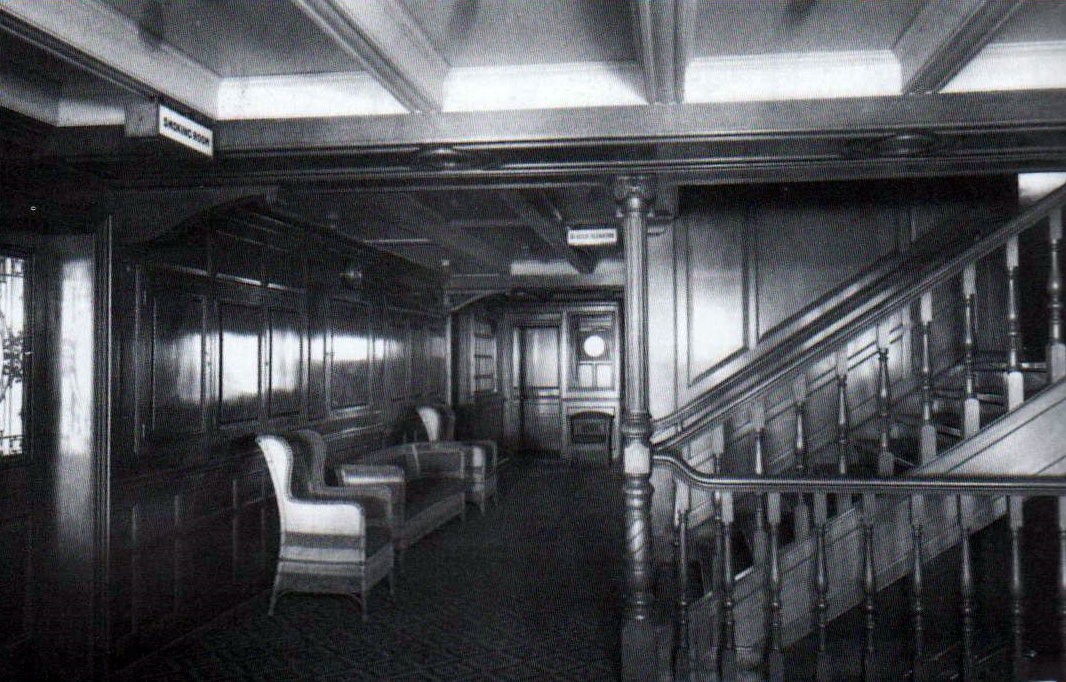
Second Class Smoking Room
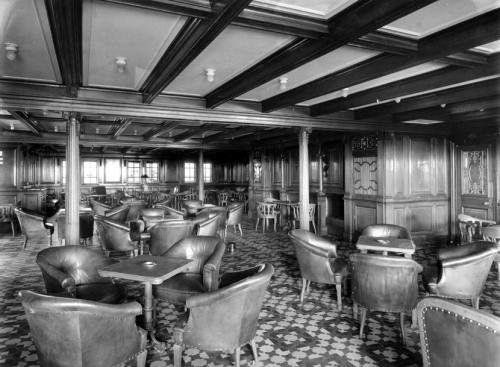
After dinner, the gentlemen of the Second Class could retreat from the Dining Room to their Smoking Room, decorated in Louis XVI style with oak panelling and Daido rails. Linoleum tiles specially designed for the room were unique to the ship.
Second Class Library
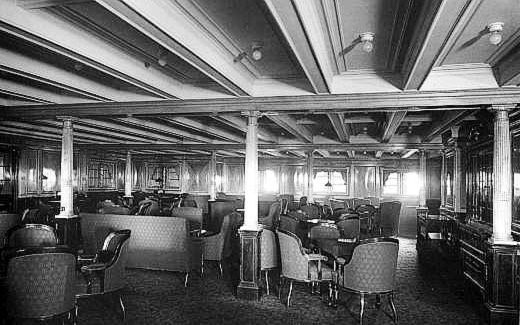
After dinner, the Second Class ladies would part company from their partners and retire to the excellently appointed Library filled with mahogany furniture - the equivalent to the First Class Reading and Writing Room. A large bookcase was situated at the forward end opposite the bulkhead. Large windows had silk curtains. The rich Wilton carpet gave a snug feel.
Second Class Dining Room
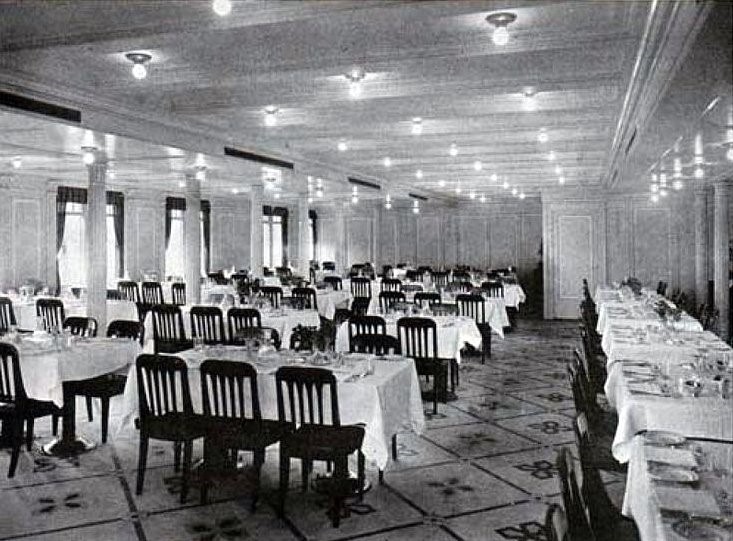
The Second Class Dining Room was 71 feet long large enough to seat 2394 people at one sitting. This elegant room had oak panels with pivoted sidelights and there was a piano in the room to provide background music. All the furniture was mahogany with crimson upholstery.
Second Class Accommodation
Accommodation comprised either two or four berth rooms for up to 550 passengers. All the rooms were fitted in enamel white with mahogany furniture. The Staterooms of the Second Class were similar to the standard cabins of the First Class. However, when comparing the size of the rooms, staterooms and the galleys etc., it must be remembered that the Titanic and the Olympic set entirely a new standard of transatlantic travel. The Second Class (or Middle Class) would have been treated in exactly the same way as the First Class passengers on other contemporary shipping lines.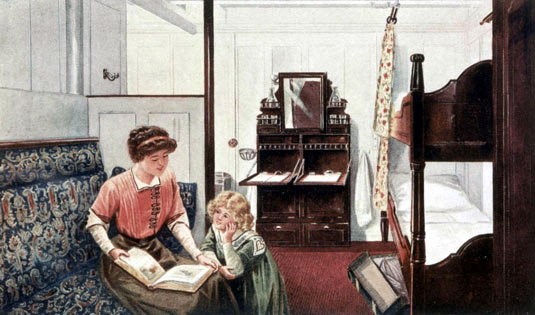
Third Class Travel
Third Class accommodation was much less luxurious than Second Class. Even so, the Third Class or Steerage passengers, as they were also known, still enjoyed levels of luxury compared to most liners of their day.
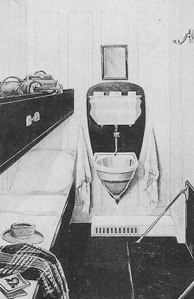
There were over 1000 Third Class passengers on the Titanic. Their accommodation was much more modest than the First and Second Classes. There were only 84 two-berth cabins on board, most of the accommodation comprised mainly of two to six berth rooms.
The size of the rooms compared to First and Second Class reflected the class-conscious attitudes of the age. The First Class Turkish Baths was larger than the Third Class galley. A thousand passengers would rely on the galley but only a handful would have used the Turkish Baths.
Nevertheless, the designers wanted to change the attitudes towards Third Class travel. The Third Class cabins were not dormitories but individual closed cabins, thus adding some privacy to the passengers, but many would still have to share with strangers.
Third Class General Room and Smoking Room
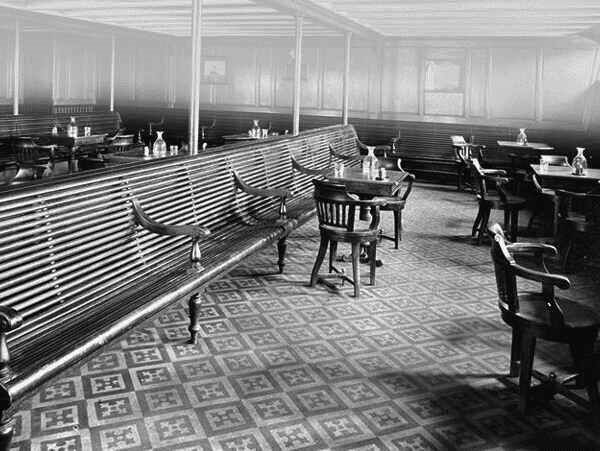
The General Room was the heart and soul of the Third Class community as the main meeting room. It was panelled in pine and finished in enamel white with teak furniture.
The Smoking Room (pictured right) was panelled and furnished in oak with teak furniture and was very comfortable. The WSL gave much consideration to the third Class passengers, many of whom would be crossing the Atlantic to start new lives away from countries left behind. The WSL wanted them to enjoy the voyage as a good start to their “new life.”
Third Class Dining Room
The Third Class Dining Room, situated on the Middle Deck, was 100 feet long and extended the full width of the ship. It could seat approximately 470 passengers in each of the three sittings. The pantries and galley were situated behind the Dining Room.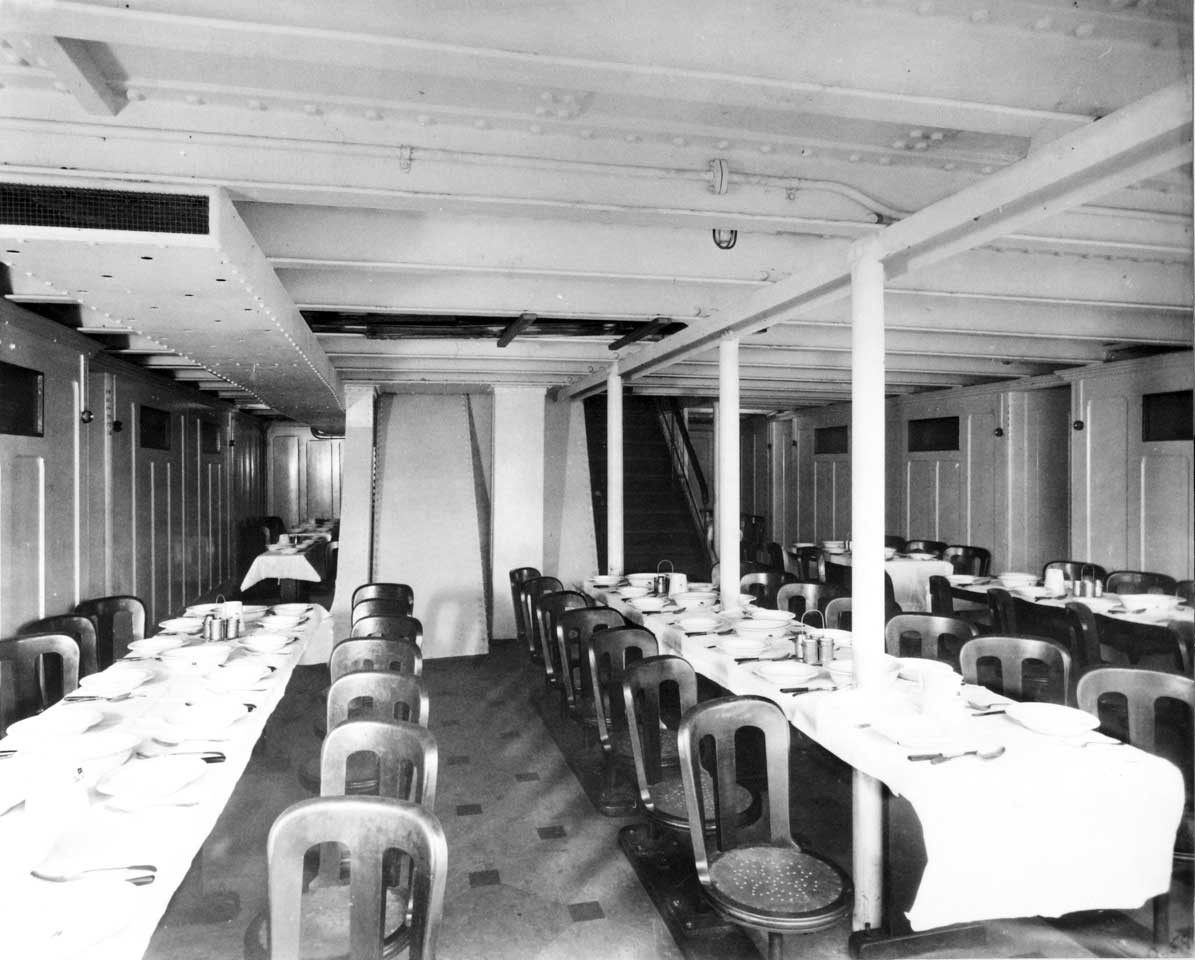
RMS Titanic Crew Accommodation
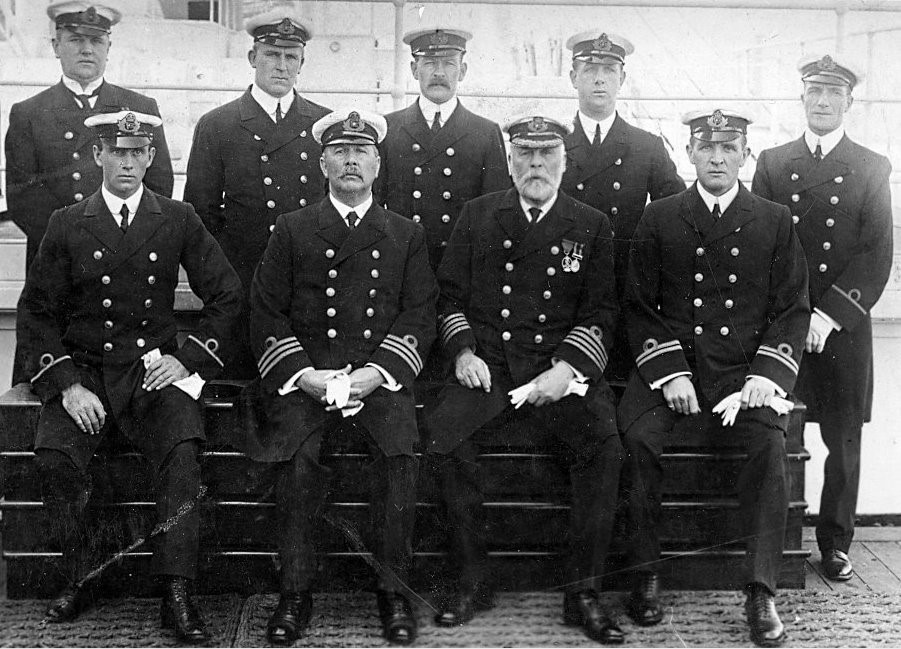
Back Row: Chief Purser Hugh Walter McElroy; Sub-Lieutenant Charles Herbert Lightoller, RNR; Mr. Herbert John Pitman; Sub-Lieutenant Joseph Groves Boxhall, RNR; Sub-Lieutenant Harold Godfrey Lowe, RNR
Front Row: Mr. James Paul Moody, Lieutenant Henry Tingle Wilde; RNR; Commander Edward John Smith, RNR; Lieutenant William McMaster Murdoch, RNR.
| Name | Age | Position | Hometown |
| Commander Edward John Smith, RNR (Retd) | 62 | Captain | Hanley, Stoke-on-Trent, England |
| Lieutenant Henry Tingle Wilde, RNR | 39 | Chief Officer | Walton, Lancashire, England |
| Lieutenant William McMaster Murdoch, RNR | 39 | First Officer | Dalbeattie, Kirkculbrightshire, Scotland |
| Sub-Lieutenant Charles Herbert Lightoller, RNR | 38 | Second Officer | Netley, Hampshire, England |
| Mr. Herbert John Pitman | 34 | Third Officer | Castle Cary, Somerset, England |
| Sub-Lieutenant Joseph Groves Boxhall, RNR | 28 | Fourth Officer | Hull, Yorkshire, England |
| Sub-Lieutenant Harold Godfrey Lowe, RNR | 29 | Fifth Officer | Barmouth, Merionethshire, Wales |
| Mr. James Paul Moody | 24 | Sixth Officer | Grimsby, Lincolnshire, England |
